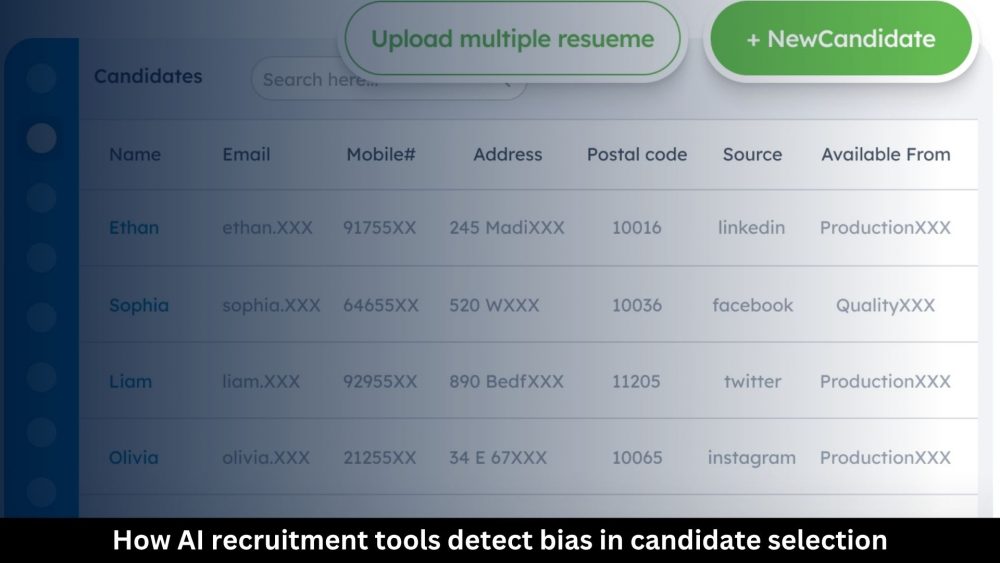Can AI really detect hiring bias?
At a time when diversity, equity, and inclusion are top priorities for HR strategy, businesses face mounting pressure to recruit without bias. But human bias, whether conscious or unconscious, can whisper under the surface to influence even the most well-intentioned hires. This has raised a fundamental question: Can artificial intelligence help organizations spot and diminish bias in choosing which candidates to interview?
The solution is in why AI Recruitment Tools work, they are structured to identify patterns of discrimination, spot inconsistencies, and lead with fairness in hiring. Let’s take a closer look at how these tools work, the technology underpinning them and what companies need to do to make use of them responsibly.
Understanding Bias in Candidate Selection
Candidate selection bias is favouritism or discrimination against some applications on the basis of gender, race, age, name, education or even perceived personality. Common types of Bias in Candidate Selection include:
- Affinity bias: Preferring candidates who share your interests or background.
- Gender discrimination: Beliefs derived from roles or stereotypes about women and men.
- Confirmation bias: Processing information in a way that conforms us to our predetermined beliefs and ideas.
- Name bias: Preferring names that feel more familiar or culturally dominant.
These biases are frequently non-conscious and hard to overrule through explicit control. This brings AI in recruitment process into play.
How Recruitment Tools for the AI Industry Are Being Trained to Spot Biases
AI hiring technology is only as good as the data it learns from and, in most cases, that is thousands or more job applications with details about applied-to jobs and outcomes (easily 100x) as well as behavioural feedback. Here’s how it detects bias:
Pattern Recognition and Data Analysis
AI systems spot patterns in hiring data that humans might otherwise overlook: If, say, a company has a long history of hiring men over women for leadership positions, an AI tool can flag that as potential bias.
Audit Trail of Decisions
Today’s AI hiring tools typically keep extensive logs of the reasoning behind their decisions, such as which attributes a candidate possessed that affected one recommendation or another. This level of transparency would make it simpler to identify if irrelevant criteria, such as the name or address of a candidate, are driving biased decisions.
Debiasing Algorithms
A number of vendors of AI hiring software employ debiasing algorithms to down weight bad representations. For instance, if resumes are anonymized, name is removed, or photo of the resume censored, no shortlisting bias can be implemented.
Comparative Analysis
AI can compare how candidates of comparable qualifications are treated. If there are disparities, it signals to the recruiters that they may have a bias.
Critical Attributes That Facilitate Bias Identification in AI Solutions
Below are a few different areas where AI can discover and eliminate bias:
- Blind Screening Capabilities: Resumes can be anonymized with AI to ensure candidates are assessed solely on their skills and experience. This is being a drastic configuration toward an impartial admission.
- Diversity Dashboards: Many modern platforms offer analytics dashboards to monitor hiring trends by gender, ethnicity, location and age.
- Language and Sentiment Analysis: AI parses the tone and language of job descriptions or interview notes to read sentences for biased language that might deter diverse applicants.
- Standardized Assessments: Unlike from unstructured interviews, AI bases on structured assessments so it guarantees that every candidate is tested fairly; and equally.
Real-World Use Cases: How to Detect Bias Here are two examples in practice.In fact, some organizations already are applying AI to the recruitment process to eliminate bias:
- Unilever is using artificial intelligence-powered video interviews that assess facial expressions, tone and word choice. Applicants are judged by the program objectively with set criteria.
- Accenture introduced AI to screen resumes without revealing identity cues such as names and graduation years so that hiring is not biased.
- Google bolstered its practice of a structured interview methodology by implementing machine learning to maintain standardized and cultural-bias free questions.
The Role of Data in the Detection of Bias
With AI hiring software, the tool is only as good as its data sets. And, if the historical hiring information these programs are fed is biased, then the A.I. tool could inadvertently reproduce those biases.
As a result, AI hiring software leaders are including:
- Bias audits to periodically check for the fairness of AI outputs.
- Routine updates as we constantly add new and the latest candidate’s information.
- Feedback loops to train on hiring managers’ decisions and candidates’ outcomes.
Principles for Fair AI Hiring Best Practice: Exclude Bias in the Training Data What is it?
So that AI is a force in fair hiring, companies should adhere to these best practices:
- Audit constantly: Regularly examine patterns and results of hiring to detect subtle biases.
- Define clear fairness goals: Ensure that AI is trained with objectives that prioritize fair treatment for all candidate groups.
- Teach hiring managers: Train recruiters to understand the parsing of AI recommendations and not rely too heavily on them.
- Use the right tool: Invest in AI that values fairness as well as efficiency.
There are many solutions available, of which understanding the Best Recruiting Software for Small Business that also has inherent Bias Mitigation features for smaller teams with low bandwidth HR.
Advantages of AI on establishing an unbiased hiring process
AI has shifted traditional hiring in powerful directions:
- Speed: In a matter of seconds, AI can review thousands of resumes, bringing the time it takes for bias to seep in down to nearly zero.
- Objectivity: AI doesn’t “like” or “dislike” a candidate for emotional or unconscious reasons.
- Scalability: As you scale hiring, every candidate gets subjected to a uniform screening process thanks to AI.
- Transparency: Audit trails and analytics can be used to defend every decision made through AI tools in talent acquisition.
Together, these benefits encourage an unbiased recruitment method in every industry.
Challenges and Limitations
But for all of their promise, AI-powered hiring tools are not infallible. Some challenges include:
- Biased training data: If previous hiring patterns were biased, it could have learned and mimicked that.
- Excessive dependence on automation: Recruiters might follow AI recommendations as they are without involving human judgement.
- Legal Risks: Companies could come under scrutiny should it turn out that AI is contributing to discrimination, whether knowingly or inadvertently.
That’s why companies need to use AI hiring software that is transparent, overseen by humans and committed to ethical use.
The Future of AI and Fair Hiring
AI in recruiting is evolving and as the tech matures it’s going past basic screening and toward decision support, bias prediction, and even empathy mapping. We’re not so many years away from a world where every stage of the hiring process, down to individual job descriptions, sourcing for candidates, shortlisting those candidates, subsequent interviews and interview feedback, can be optimized for fairness with the help of AI.
Crucially, this isn’t simply about technology. It’s about building trust. That demands that companies make fairness, inclusion and accountability a priority from the top to the bottom.
Conclusion: Rethinking Hiring with Fair AI
With today’s competition for jobs only getting fiercer, companies can ill afford to pass over top talent because of a flawed or biased hiring process. In short, by using AI for recruiting, companies not only get faster and more efficient hiring, they get a tireless partner in their quest for fair hiring.
The path towards fair hiring doesn’t only run through technology, it’s also led by accountability. Whether you’re a corporate company ramping up your talent pipeline or a fast-growing business looking for the Best Recruiting Software for Small Business, incorporating AI based on fairness is now the way of doing things.
With ai tools for recruitment, it’s not just about filling roles, it’s about building inclusive, high-performing teams that feel that way too!



